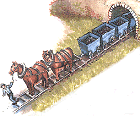By 1800
a canal had been built up the Swansea
valley and tramroads had also been
constructed over the mountains to the north.
This meant that coal, limestone, and iron ore could be brought to the
ironworks more easily, and the iron that was made there could be transported
by canal to the port of Swansea,
and then sent around the world by sea. (See the
map on the Story of Iron smelting 1
for the route of the canal).

